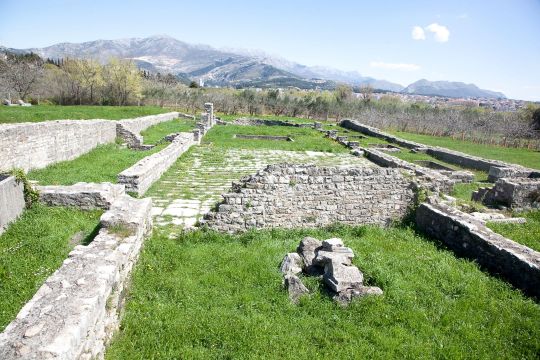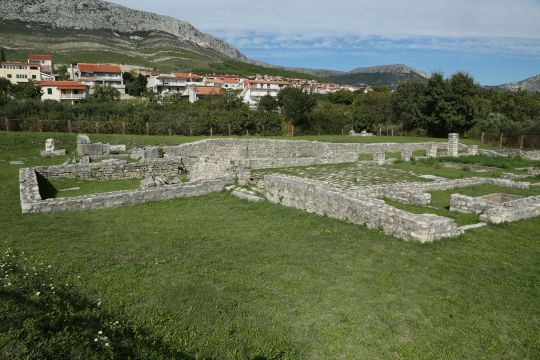Named after the nearby creek, Kapljuč, that flows down the Mount Kozjak side into the sea, some two hundred metres away from the amphitheatre, near the town walls, there is the oldest Salonitan cemetery basilica, also known as the Five Martyrs’ Basilica. It was dedicated to the priest Asterie and four soldiers of the emperor’s guard: Antiohie, Gaian, Paulinian and Telie, who, being Christians, suffered martyrdom during the Diocletian’s prosecutions in 304. They were buried in a small cemetery outside the town walls, firstly pagan and later, since the fourth century, after their burial and the building of the church there which was also Christian.
In Salona, like elsewhere in the then world, burials of Christian community members started around such martyrs’ graves. Thus in Kapljuč, as well as in other Salonitan cemeteries, there are several layers of various graves dated from the first to the fourth centuries, from simple and humble ones in amphorae and under tegulae, to lead coffins, sarcophaguses and vaulted mausoleums (the so-called a pozzo), with or without atria, including several dozen valuable and rich inscriptions.
As assumed by Ejnar Dyggve, in the mid fourth century, at the time of the bishop Leontius (346-381), a church was built above the grave of one such martyr, the first Salonitan cemetery church. In 1909, in this church there was found a uniquely positioned and decorated grave, with a large stone slab, decorated with four circles and a rectangular hollow. The slab was of special cult (ritual) importance, making this scientifically a very interesting grave subject matter of many discussions. The slab was probably used for placing food and drink during rituals, which means it could have been pagan. Still, it was well taken care of when the church was built, this demonstrating its importance in the Christian ritual, too. This situation is also confirmed by the position of the surrounding mosaics. One can read the names on the mosaics of the above martyrs. One of them also reads: Die octavo calendas maiarum votum fecit ad martyrem Asterium, i.e. on the eight day of the calends of May, he made a vow to the martyr Asterius. Their earthly remains - the relics - were probably kept under the altar. All this indicates the gradual development of rituals in the early Christian époque.
The archaeological complex of Kapljuč consists of a church, erected above remains of earlier structures, a few memorials and annexes, the cemetery and outbuildings with a preserved press, reconstructed by E. Dyggve.
Excavations started here in 1871 when F. Bulić discovered a small necropolis near the north walls, including 16 sarcophaguses lined in a row to the east from the presently visible basilical complex. After that, in the meadows of Kapljuč to the north of the wall, archaeological discoveries started appearing. At the beginning of the twentieth century, under a pile of rocks (so often in Solin), remains of a building were found: apse, lateral walls of church aisles, sarcophaguses, below the church floor level, and a “crypt” below the apse. Bulić concluded it was a valuable site that required comprehensive research and, being unable to raise enough money for such an undertaking, left this job for many years for a Danish archaeological mission that excavated in Kapljuč in 1922 and again in 1923.
[Edit mode] Swiper Gallery: att Kapljuc









